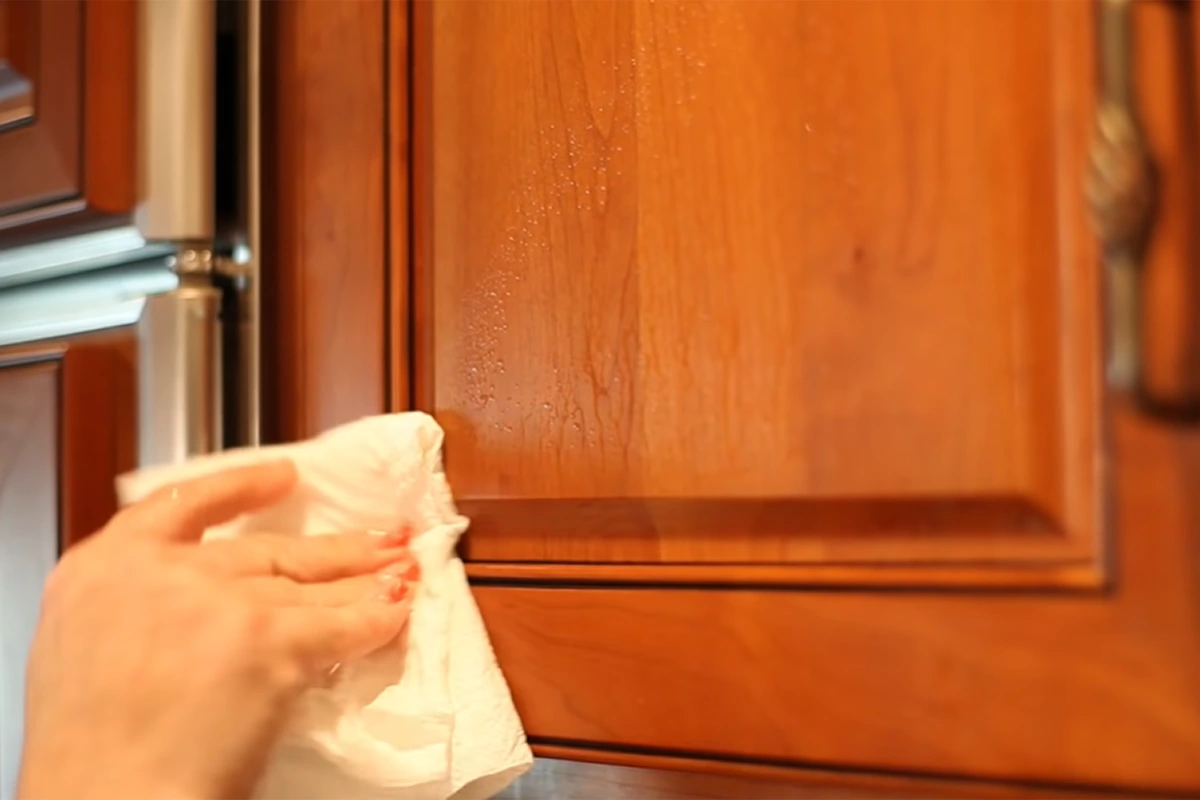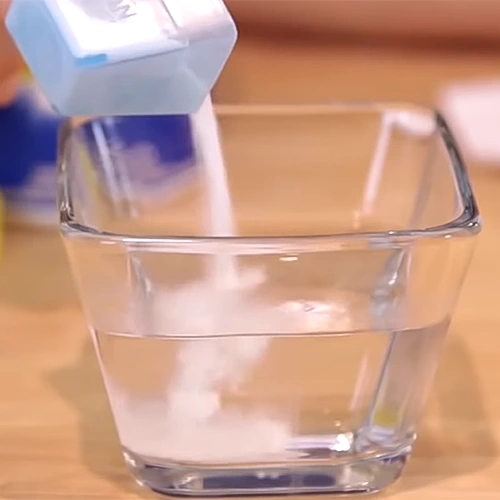
When you clean your wood cabinets, using the wrong household cleaners can actually damage finishes and do more harm than good. Many cleaners you likely have under your sink contain ingredients like bleaches, ammonia, acids, abrasives, and alcohol that wear away protective layers on wood over repeated use. This leaves your cabinetry susceptible to staining, discoloration, swelling, and deterioration over time.
To preserve the quality and beautiful appearance of your wood cabinets, it’s crucial you know which cleaners to avoid and use specially formulated wood cleaners instead.
This article covers the top household cleaners that you should keep far away from your wood cabinet surfaces based on their harsh chemicals.
With these insights, you can make informed choices when cleaning about which products to use safely on your wood cabinets without gradually damaging them.

13 Household Cleaners You Should Never Use on Wood Cabinets
1. Hydrogen Peroxide
I know it seems harmless, but hydrogen peroxide can actually bleach and discolor wood finishes over time. It’s an oxidizing agent, so it can react with the pigments and dyes in wood stains and varnishes. A dilute hydrogen peroxide solution may be okay for quick cleaning, but avoid letting it sit or using higher concentrations. Ultimately, it’s safer to use a dedicated wood cleaner to avoid potential chemical reactions with your cabinets’ finish.
2. Bleach

Bleach may be great for sanitizing and getting whites their whitest, but it’s much too harsh for finished wood. Bleach contains sodium hypochlorite which can easily strip the protective finish right off your cabinets. Once that happens, the bare wood underneath is exposed and more prone to staining and water damage. I recommend keeping bleach far away from your wood surfaces – stick to using it only on whites in the laundry room!
3. Ammonia
You might already know that ammonia is found in glass cleaners because of its ability to cut through grease. Well, the same properties that make ammonia good at cleaning windows make it bad for wood finishes. The ammonia reacts negatively with stains, dyes, and varnishes, often discoloring or even damaging the surface. Always check the ingredients on any cleaning product before using it on wood cabinets. Ammonia should be avoided to maintain that smooth finish.
4. Vinegar
We all know vinegar is a natural cleaning product. However, that high acidity can wear away at wood finishes when used repeatedly over time. While a diluted vinegar solution is okay for occasional use, I’d steer clear of using vinegar as your go-to for cleaning cabinets. Opt for wood cleaners with gentler ingredients to get that streak-free shine without slowly damaging the finish each time you clean.
5. Alcohol-based Cleaners
Do you know how alcohol can strip away nail polish? Well, it works similarly on wood finishes. The alcohol breaks down the protective coatings on wood, causing hazing, discoloration, and damage over time. It’s best to keep the cabinet doors closed when using alcohol-based cleaners like hand sanitizer so the fumes don’t come into contact with the wood. For purposefully cleaning cabinets, use a mild detergent or wood cleaner instead.
6. Abrasive Cleaners
Abrasive cleaners like soft scrub or anything with grit in it can literally scratch and scour your cabinets’ surfaces. Any scratches made degrade the quality of the finish and leave the wood underneath prone to staining and moisture damage. It’s better to use microfiber cloths and soft sponges with mild detergent to clean wood cabinets gently but effectively. Your cabinets will look great without ruining the finish quality.
7. Citrus Cleaners
Citrus-based cleaners contain acidic fruit juices that can wear away wood finishes over repeated use. While they smell great and are more natural, stick to citrus for cleaning non-wood surfaces like countertops, appliances, mirrors, and glass. For wood cabinet cleaning, use specialty wood cleaners instead to clean and polish without causing gradual damage from the acids.
8. Furniture Polish with Silicone
Furniture polish makes wood shine, but many contain silicone that can leave behind a gummy, waxy buildup on the surface over time. This residue attracts dirt and dust and makes the cabinets look dull or dirty again soon after polishing. It’s better to use silicone-free polish or mild soap and water. Your cabinets will get that beautiful, glowy finish without the gross silicone residue.
9. Mineral Spirits
Mineral spirits are a powerful solvent used for degreasing and stripping away coatings. As you can imagine, this makes it terrible for wood finishes! Even a diluted mineral spirit solution can dissolve protective varnishes and finishes on cabinets over repeated use. I’d avoid this one altogether on wood surfaces. Mild detergent or specialty wood cleaners are far better options.
10. Steam Cleaners
While steam cleaners deeply sanitize surfaces using very hot steam, they aren’t ideal for wood furnishings. The excess heat and moisture from the steam can cause wood to crack, swell, and ultimately get damaged. For deep cleaning wood cabinets, use a mild detergent solution instead. And always make sure to dry the wood thoroughly after cleaning to avoid water damage.
11. Window Cleaners with Ammonia/Alcohol
Some popular window cleaners like Windex contain ingredients like alcohol or ammonia that are harmful to wood finishes, as we covered earlier. It’s easy to forget and spray cabinets down with window cleaner out of habit. But even a little contact with these chemicals when cleaning nearby windows is enough to cause some subtle damage to the wood over time.
12. Oven Cleaners
Oven cleaners are extremely caustic and corrosive – that’s how they cut through seriously burnt-on grease. But that also makes them incredibly damaging to wood surfaces and finishes. Just a few minutes of contact with oven cleaners could cause serious erosion and discoloration. Oven cleaners belong in the oven only! Keep them far away from the cabinets at all times.
13. Multi-Surface Cleaners
Cleaners designed for use on multiple surface types often contain harsh ingredients meant to cut through dirt and grime on things like countertops. But these same ingredients, like bleach, ammonia, acids, and alcohol can be detrimental to wood cabinet finishes when cleaning adjacent surfaces. Be sure to check labels and use wood-specific cleaners only on your cabinets.
Final Thoughts
When it comes to keeping wood cabinets in good condition, it’s imperative to avoid using the wrong cleaners that can damage finishes and degrade the wood over time.
Household products containing bleaches, acids, abrasives, and harsh chemicals will wear away protective layers and leave cabinetry prone to discoloration, staining, and swelling.
Instead, invest in specialty wood cleaners with gentle, non-damaging ingredients tailored to preserve wood quality without stripping or eroding finishes. Check labels on any new cleaning product before use and do a spot test on inconspicuous wood to confirm compatibility.
